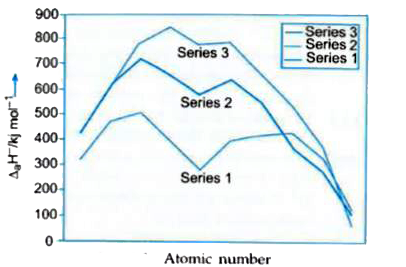Explain giving reasons :
(i) Transition metals and many of their compounds show paramagnetic beaviour.
(ii) The enthalpies of atomisation of the transition metals are high.
(iii) The transition metals generally form coloured compounds.
(iv) Transition metals and their many compounds act as good catalyst.
(ii) Enthalpies of atomisation of the transition metals are high. Energy required to separate the atoms from the lattice is known as enthalpy of atomisation. Transition metals have a high value of enthalpy of atomisation. This is indicated by high m.p. and b.p. of transition elements. They display typical metallic properties such as high tensile strength, malleability, ductility, high thermal and electrical conductivity and metallic lustre.
High value of enthalpy of atomisation is attributed to involvement of (n - 1)d electrons in addition to the ns electrons in the interatomic metallic bonding. The maxima at about the middle of each series indicate that one unpaired electron per d orbital is particularly favourable for strong interatomic interactions. In general, greater the number of valence electrons, stronger is the resultant bonding. Enthalphy of atomisation is an important factor in determining the standard electrode potential of a metal, metals with very high enthalpy of atomisation (i.e., very high boiling point) tend to be unreactive. It is found from the figure below that the metals of the second and third transition series have greater enthalpies of atomisation than the corresponding elements of first series.

Related Playlists
- BOOK - U-LIKE SERIESCHAPTER - THE D-AND F-BLOCK ELEMENTS EXERCISE - CASE BASED/SOURCE-BASED INTEGRATED QUESTIONS15videos
THE D-AND F-BLOCK ELEMENTS
- BOOK - U-LIKE SERIESCHAPTER - THE D-AND F-BLOCK ELEMENTS EXERCISE - MULTIPLE CHOICE QUESTIONS20videos
THE D-AND F-BLOCK ELEMENTS
- BOOK - U-LIKE SERIESCHAPTER - THE D-AND F-BLOCK ELEMENTS EXERCISE - SELF ASSESSMENT TEST (SECTION A ) MULTIPLE CHOICE QUESTIONS (CHOOSE THE CORRECT OPTION)7videos
THE D-AND F-BLOCK ELEMENTS
- BOOK - U-LIKE SERIESCHAPTER - SURFACE CHEMISTRYEXERCISE - SELF ASSESSMENT TEST ( SECTION A)7videos
SURFACE CHEMISTRY
- BOOK - U-LIKE SERIESCHAPTER - THE P-BLOCK ELEMENTS EXERCISE - SELF ASSESSMENT TEST ( SECTION A)7videos
THE P-BLOCK ELEMENTS
Similar Questions
Explain giving reason:
(a) Transition metals and many of their compounds show paramagnetic behaviour.
(b) The enthalpies of atomisation of the transition metals are high.
(c). The transition metals gnerally form coloured compounds.View SolutionExplain gives reason.
(a) Transition metal and many of their compounds show paramagnetic behavior.
(b) The enthalpies of atomisation of the transition metal are high .
(c) The transition metals generally from coloured compounds.View SolutionExplain gives reason.
(a) Transition metal and many of their compounds show paramagnetic behaviour.
(b) The enthalpies of atomisation of the transition metal are high .
© The transition metals generally from coloured compounds.View SolutionWhich of the following statement(s) is/are correct?
(A) Transition metals and many of their compounds show paramagnetic behaviour.
(B) The enthapies of atomisation of the transition metals are high
(B) The transition metals generally form coloured compounds
(D) Transition metals and their many compounds act as good catalyst.View SolutionExplain why transition metals and their many compounds act as good catalyst.
View SolutionExplain why transition metals and their many compounds act as good catalyst.
View SolutionExplain why transition metals and their many compounds act as goodd catalyst.
View SolutionExplain why :
Transition metals and their compounds act as catalyst.View SolutionExplain why transition metals form complex compounds.
View SolutionWhy are compounds of transition metals, generally coloured ?
View Solution

